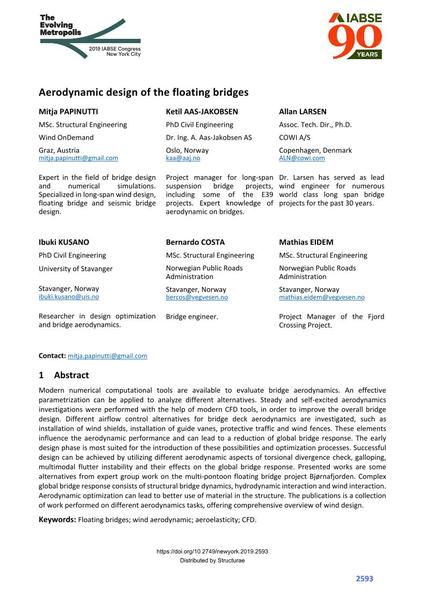Aerodynamic design of the floating bridges

|
|
|||||||||||
Bibliografische Angaben
| Autor(en): |
Mitja Papinutti
(Wind OnDemand)
Ketil Aas-Jakobsen (Dr. Ing. A. Aas-Jakobsen AS) Allan Larsen (COWI A/S) Ibuki Kusano (University of Stavanger) Bernardo Costa (Norwegian Public Roads Administration) Mathias Eidem (Norwegian Public Roads Administration) |
||||
|---|---|---|---|---|---|
| Medium: | Tagungsbeitrag | ||||
| Sprache(n): | Englisch | ||||
| Tagung: | IABSE Congress: The Evolving Metropolis, New York, NY, USA, 4-6 September 2019 | ||||
| Veröffentlicht in: | The Evolving Metropolis | ||||
|
|||||
| Seite(n): | 2593-2598 | ||||
| Anzahl der Seiten (im PDF): | 6 | ||||
| DOI: | 10.2749/newyork.2019.2593 | ||||
| Abstrakt: |
Modern numerical computational tools are available to evaluate bridge aerodynamics. An effective parametrization can be applied to analyze different alternatives. Steady and self-excited aerodynamics investigations were performed with the help of modern CFD tools, in order to improve the overall bridge design. Different airflow control alternatives for bridge deck aerodynamics are investigated, such as installation of wind shields, installation of guide vanes, protective traffic and wind fences. These elements influence the aerodynamic performance and can lead to a reduction of global bridge response. The early design phase is most suited for the introduction of these possibilities and optimization processes. Successful design can be achieved by utilizing different aerodynamic aspects of torsional divergence check, galloping, multimodal flutter instability and their effects on the global bridge response. Presented works are some alternatives from expert group work on the multi-pontoon floating bridge project Bjørnafjorden. Complex global bridge response consists of structural bridge dynamics, hydrodynamic interaction and wind interaction. Aerodynamic optimization can lead to better use of material in the structure. The publications is a collection of work performed on different aerodynamics tasks, offering comprehensive overview of wind design. |
||||
| Stichwörter: |
CFD
|
||||

